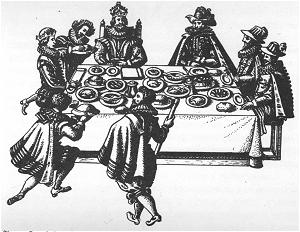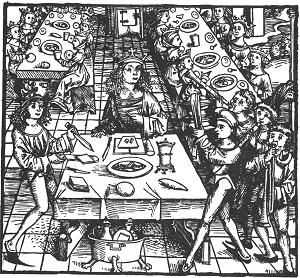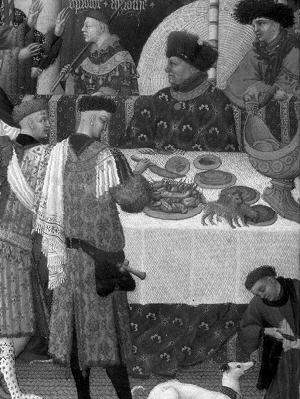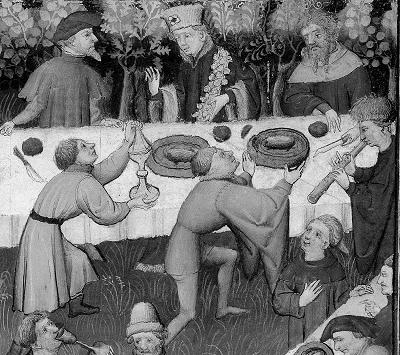| Home |
| La Feste |
| Food |
| Table Service |
| Music |
|
|
| Who are we? |
The RolesIn a great household, the following roles are part o
Steward
- oversees all the domestic management.
For this Feast:Master Aleksander Yevsha is Marshall of the Feast.Master Tibor and Lady Eleanor will serve as ewerers to high table, the livered servants will handle laving for the others. There is no pantler, the bread being served is all machets and festive little rolls. Manchets will be pre-set, but for the second course, the servants will have to bring out the little rolls in a basket and lay them at each guest's place. Baron Tibor will be kerver for high table. As needed the other ushers will kerve for the guests as well. André will assist at high table as needed. The main dishes requiring kerving are the boar roast (1st course), turkey-duck-veal roast (2nd course). Guests may also want help with the patridges in a pastry (1st course). The standing pies should also be kerved. The technique used is to neatly cut out the top of the pie around the edges and remove it, then scoop out the contents for the guests. The top pie crust may be offered to the guests. Carving tools and serving spoons will be set out by the "feature roast" on each side of the "U." Master Yevsha is butler. There will be a sideboard with all the drinks on it. Guests should bring their beverages to him before dinner. They will be decanted as needed and labelled, and the ushers will serve them to the guests when requested. The ushers will act as cupbearers to their tables. When guests want a drink, they should request it from their servants, who will fill their cups from their bottles (or with the non-alcoholic drinks, water and verjuice). Eleanor with serve high table as cupbearer. Isabella's cupbearer will serve Isabella The Sewer is Adele Mallory (André for tonight). The ushers are Ki-Lin (Pascal), Sylvia (Sylvius), Lilias (Lilius), Michael Graham (Michel), Ayden, Donal Artur , Leucum (Lucian ), Isabella's cupbearer . For high table, the Sewer, Tibor, and Eleanor (if needed) will usher. There will be no tasters. Preparing for the Feast
Setting the TableThe ewerer and the marshall or sewer normally lay out the table linens. The are typically 3 cloths at the high table: one is laid down the center of the table and the other two are laid at its edges so as to hang down on the sides. Clean linen is highly desirable, and neatly pressed into fine sharp squares all the more desirable. The laying down of the cloths is often accompanied with a certain amount of kneeling and hand kissing (kissing one's own hand, a common method of showing respect). If anyone is watching, it could be nice to perform this ceremony for the high table before dinner.For this feast: the handmade table linens are wide, 60". There will be two at high table. One will have a decorative border, this border should hang down in front. For the other tables, there is one cloth a piece. SaltAfter the table cloths, the salt cellars are placed on the table. There is usually a grand salt that is placed on the high table near the lord of the hall, and smaller ones scattered about the tables for others to use. Salt is an ancient symbol of hospitality, as well as a necessary and valuable spice, and being near the master salt is a sign of honor.For this feast: There is a larger bronze salt cellar to put in the center of the high table, with two small ceramic ones on either side. There are 12 other small ceramic ones to be placed on the other tables, one for every 3 people. Next the trenchers, knives, spoons, & napkins, are normally laid out at each place. In later times, the trenchers are pewter plates. In earlier times, they are flat loaves of stale bread. Trenchers can also be made of wood. For this feast: guests are all getting a pewter plate, a silver goblet, a napkin (folded on top of the plate), and a pewter spoon. A manchet (for the first course) or a couple of festive rolls (for the second course) are part of the preset. Drinking vessels are usually kept on the cupboard, then brought to each diner when requested, rinsed out, and placed back on the cupboard to be shared. For this feast: guests will keep their own goblets. Bottles, jugs, pitchers will be kept on a sideboard, and the liveried servants will take the goblet, fill it, and return it to the guest. Other preset for this feast includes the sauces, and the servants carving tools and serving spoons, which will be arranged by the "feature roast." LavingClean hands before you eat is very important to medieval manners. A lot of your food is eaten with your hands out of communal dishes, and this is a matter of basic civility. Laving can be done quite ceremoniously. Two servants bring around ewer and basin starting with the highest ranking person.The washing should be done by VERY CAREFULLY, slowly pouring water from the ewer over the guests hands, with the other servant holding the basin below to catch the drops. The ewerer will then offer the towel on his arm for the guests to dry their hands. Lower ranking guests may wash their hands before sitting down at the table. A laving board, usually near the entrance to the hall, should have a basin, ewer, and towels set up for people to use as they come in. Laving was also done after dinner, when your hands are really dirty. Most medieval food was eaten with your hands, and by the time dinner is over you need to wash again. For this feast: Baron Tibor and Lady Eleanor will do formal laving for the high table, with an aquamanile and basin. For the other guests, liveried servants will bring around bowls of water, and carry a towel. They will not have ewers. The hand washing is large ceremonial, even in the middle ages you were expected to have washed ahead of time. Seating
For this feast: see the seating chart. BreadBread is usually laid out as part of the preparation. Bread is a crucial part of the meal. It is not only food, it is used to clean your utensils and sop up sauces. For the high table, the pantler carves up the bread into perfectly rectangular pieces, without crusts, and make neat little pyramids of slices before the honored guests. The pantler should use a bread knife to do this job. Then the pieces that have been cut should be laid before the master or guest using a presentoir. This is a broad-bladed round-ended knife, rather like a long spatula or a cake server.For this feast: For the
first course there will be manchets. Manchets are rolls of fine white bread,
very prestigious. Each guest will have one in the preset, set to the left
of their plate. For the second course there will be delectable little rolls
with cheese and other fillings. Each guest will get two (brought around
in a basket between courses and set on the table)
Serving the DishesKitchens normally had a staging area for arranging the dishes to be served. The dishes are brought from this area to the tables by servants in procession. Food always goes first to the high table, and then to others, in order of precedence. Serve the king first. Serve the right hand side of the table before the left.After the servants present the dishes for high table, they should go down on one knee if they can.You don't have to hit the ground with this motion -- think genuflect, or a deep reverence. We suggest doing this after presenting the dish because we don't have the experience that period servers did of being able to serve directly from bended knee. It would be very bad to lose the roast. If there are Gentlemen Waiters present, give the dishes to them to place on the high table. Once the dish is on the high table, it will be kerved by a kerver. At the other tables, guests have to do this for themselves. It is considered a courtesy to carve someone's meat for them.
In a typical period meal, each prepared "dish" would be apportioned into "messes." Two to six people would be expected to share a "messe." It would normally be two at high table and more elsewhere. At typical society events, it is usually eight (the size of a modern "banquet" table). Guests historically got food from the messe onto their trenchers using their knives. At the high table, the kerver will take care of cutting meat and fowl and putting the pieces on the guests' trenchers. The pantler will cut and pare the bread and put it to the left of the guests trenchers'. For other dishes, like sallets or soup, the Gentleman Waiters should see about serving portions out to the guests, at least the first time around. As soon as the servants for high table have handed over their dishes to the Gentlemen, then servants shouild bring dishes to the other guests. In laying down the dishes, they should try to keep a nice symmetrical order in the middle of the table. Period household manuals stress the importance of arranging the dishes exactly, For this feast: There is a diagram for laying out the dishes (there are 12 of them). We have five tables, the high table, and 4 other tables of 9 persons, 2 on each side of the "U." There will be five of every dish, one for each table, except for the "feature roast" (boar in the first course, turkey in the second), of which there will be three (one for each leg, as shown in diagram). There will be kerving tools and serving spoons set out by the feature roast. There will be an usher to kerve on each leg of the table, Tibor to kerve at high table. Things to keep in mind: it will take a while to get out 12 dishes. We are assigning 2 servants per table. If each can carry 2 dishes, it still involves 6 trips, and some dishes can only be carried alone (the feature roast, the soup in tureens). People need to be discouraged from digging into the food until it is all out. Do this by telling them to wait for high table. They will want it carved immediately, so it is important that the designated kervers be ready to start immediately, while other servants take care of drinks and helping with the other dishes. Because people will want drinks, and giving them drinks and carving their food at the same time will cause a hectic meal experience, we will try to serve them drinks BEFORE the first dishes come out (like they do in modern restaurants). As a servant moves through the tables with a laving bowl, a servant could come behind them handling the first round of drink requests. We should allow a few minutes for this, it will be well worth it so that the first few minutes of the dinner do not become a chaotic disaster. Basic Waiting RulesWhen putting down dishes, always serve from the left side of the guest. When taking dishes away, clear from the right side of the guest.When guests are seated on one side only, this will make service much easier because you serve from the open side, rather than over anyone's shoulder.Serving BeveragesHistorically beverages were kept on a cupboard. The butler was in charge of it, with grooms to assist him. Normally the cups themselves are also kept on the cupboard. When a diner wanted a drink, the cupbearer would fetch & fill a cup and presents to the guest. It is considered bad manners to drain the cup completely. When done, the cupbearer takes the cup, empties it, rinses it, and puts it back on the cupboard.
For modern settings, the guests will want to keep their cups on the table with them, but at the high table the butler can take care of refilling cups when requested, and of asking if the high table want refills. Cups should be set to the right of the trencher. If the high table has any ale or wine that they want with the meal, it is a nice touch to collect these before dinner and decant them (if possible) into period style vessels, then set them on a cupboard where the butler can manage them. Unless there are lots of servant, modern practicality requires that pitchers of water or other drinks should just be kept on the table for everyone but high table. Servants should see to it that these pitchers are kept full. Notes on using period drinking vessels: Earthenware vessels are porous even when they are well-glazed. When they are filled with liquid they are heavy. If you are pouring anything from an earthenware jug, always grip the handle in one hand, and put your other hand underneath the bottom of the jug to support it. Do not carry all its weight from the handle only, it might come right off. For this feast: guests will give their beverages to the Butler, Master Yevsha. We will provide water and a mixture of verjuice and water (tastes like lemon water), wine and anything else is provided by the guest. The guests' beverages will be decanted if possible and labelled, and placed on a sideboard. Servants will be responsible for acting as butler's groom to six or so people, filling their drinks as needed. Eating the DishesA lot of people do not actually know how to eat their food at table. The historical procedure is to take food from the messe onto your trencher using your knife.You do the same with salt, scooping out a little from the salt cellar with the tip of your knife. It is considered bad manners to put a dirty knife into the salt; the knife should be cleaned with bread before putting it into anything. You should not put your knife into your mouth.Once you have gotten your food onto your trencher, you are supposed to cut it into small pieces and eat it with your hands. That is what God gave us napkins for. You wear the napkin over your left shoulder and use it to clean your hands as required. If there are sauces, you dip your bits of meat into the sauce and then eat it. If you have a kerver, he may kerve pieces of meat in strips with a little "handle" so that you can use the handle for dipping the meat. As for liquid items, historically you were expected to eat them with a spoon out of the common dish, or spoon them onto your bread and eat it as sops. Many SCA folk bring a bowl with them to feasts, but this is not part of the table setting on a formal table in our time period. If you want to eat in a period manner and be sanitary, you can use the sops option. Note that the courtesy books all tell people to cut their bread with a knife and not tear it into hunks.
|
|
|||||||||||||

|
|





